Is the new Max mad enough?
Yamaha launched the cult-classic V-Max in Las Vegas 24 years ago. It was the perfect place – the capital city of wretched excess – to launch a bike that quickly earned a reputation for big torque and bad attitude.
The original V-Max opened up the whole power-cruiser category. In the early 1980s, Yamaha wanted to produce a “hotrod” for American consumers. Akira Araki became the project leader, and he came to the U.S. to research the market. According to V-Max legend, he achieved a kind of satori while watching midnight drag races on a bridge across the Mississippi. Araki realized that straight-line performance was all that mattered to a lot of riders over here. He set out to create the motorcycle equivalent of a V-8 muscle car. His goal was to create nothing less than the quickest and fastest production motorcycle ever over a quarter-mile.
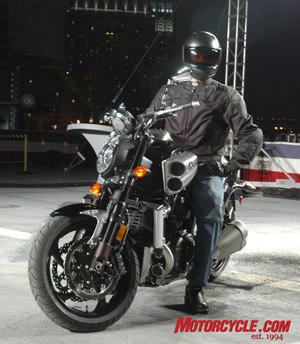 Star Motorcycles unveiled the long-awaited 2009 Yamaha V-Max on the flight deck of the USS Midway last night. The man in black is Yamaha test rider Mike Ulrich, who's one of the few people to have ridden it so far. 'It's no R1,' he admitted to us, 'but it corners a lot better than the old one.' |
 Atsushi Ichijo, who designed the original V-Max, along with project leader Mr. Nakaaki and the designer of the new bike, Mr. Umemoto. |
Araki installed himself in the offices of GDKI design in Santa Monica – Yamaha’s American design “think tank.” Ed Burke, a product planner with Yamaha’s U.S. office, served as an advisor and sounding board. John Reed, an English freelancer, also provided styling input (and is credited with designing the V-Max in some internet histories of the bike.) That said, Atsushi Ichijo was the Yamaha employee credited with penning the original.
The V-4 engine in the sedate Venture touring bike was the closest thing Yamaha had to a good old American V-8. That presented a real challenge to Kaoru Ashihara, the engineer charged with creating the motor. The Venture motor only produced about 90 horsepower, and they figured they’d need 145 to achieve their goals. They considered supercharging it, but they couldn’t figure out a way to integrate a blower into the overall design.
'His goal was to create nothing less than the quickest and fastest production motorcycle ever over a quarter-mile.'
The solution was “V-boost.” Each cylinder was fed by a single, 35mm downdraft carb, but there were two ports, between the inlet tracts for cylinders #1 & #3, and #2 & #4. At about 6,000 rpm, a butterfly valve in those ports started to open, and it was fully open by the time revs hit 8,000. Effectively, each cylinder was fed by two carbs at high rpm.
The original V-Max made considerably less than 145 hp at the rear wheel (it was more like 120, with just under 80 pound-feet of torque), but, regardless of how the bike performed on paper, riding it was a visceral experience.
V-boost wasn’t just marketing hype. Magazines tested the original model on the ’strip (the drag strip, not the Vegas Strip) and got ETs in the mid-10s with terminal speeds in the high 120-mph range. If it wasn’t the quickest and fastest proddie bike of its time, it was damn close.
The V-Max looked the part, too. It was launched in the midst of the “Mad Max” movie sequels, and shared some of their over-the-top, apocalyptic style. Some of the design choices were goofy; the two huge scoops on either side of the dummy gas tank concealed only the horns, they weren’t ram-air ducts. But customers – at least, a certain kind of customer – loved it.
The V-Max became one of the ultimate cult bikes. It stayed in the Yamaha catalog almost continuously for over 20 years. I doubt if any model of any bike has lasted longer with fewer changes. (It got stronger forks and better brakes, which improved handling and safety, but certainly didn’t transform the bike into a good handler. Part of the impression of power and speed that the bike created may well have been attributed to the rider’s subconscious knowledge that if he had to turn or stop it, he could be in big trouble.
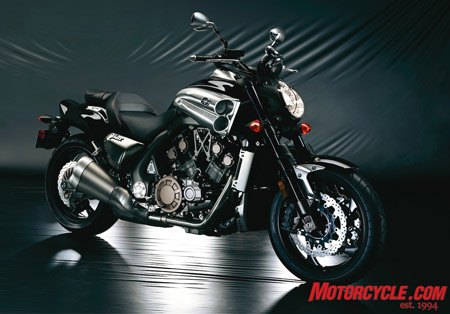
With a claimed 200 horsepower, the new V-Max is ready to rumble!
Over the years, there have been numerous rumors that a V-Max replacement was in the works. In 1999, Yamaha showed the MT-01 concept bike, which was received with enthusiasm. The “Bulldog” definitely picked up some of the Max’s styling cues. It may have been a trial balloon to see if the V-Max could be replaced by a Twin. The MT-01 was produced for the European market, but it never piqued the interest of the hardcore V-Max cultists. When sales were underwhelming and it failed to develop much of a mystique, Yamaha claimed that the Twin had never been thought of as a replacement for the V-Max, anyway. The company didn’t do much but design 20th anniversary badges for the old one.
In 2005, a stylish concept update of the Max was also unveiled in Tokyo. But when Suzuki released its brawny B-King, Yamaha got a loud, clear message from dealers and customers: “Whatever you do, the new V-Max has to make over 200 horsepower.”
The old model was kept on the shelves until 2007, long after its “best-before” date, but even so, when Yamaha seemed to quietly discontinue it, there was plenty of dismay in various chat groups frequented by V-Max cultists. (Note that until recently the ’07 Max was still listed as a Star model on the Yamaha website, presumably because there’s a few of the old ones in dealer inventory.)
“Whatever you do, the new V-Max has to make over 200 horsepower.”
That brings me to yesterday, and the deck of the USS Midway in San Diego harbor, where journalists were treated to the unveiling of an all-new V-Max, now sold (as a flagship, of sorts) under Yamaha’s “Star” brand.
So, what’s it like? Well, I can only tell you what it looks like, since none of us were allowed to ride it, even though the 1,000 foot-long deck of the Midway would have given us some clue as to whether it’s inherited its predecessor’s affinity for straight-line acceleration.
Of course, the old bike really was a straight-line only proposition; that combination of a grunty motor and hefty GVW completely overpowered the steel frame. The new frame is a swoopy cast-aluminum piece, and the visually massive new motor is a stressed element.
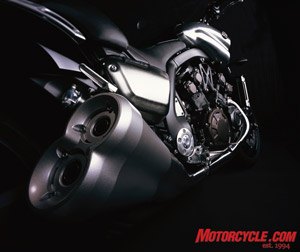 The engine is 1679cc, liquid cooled, 65-degree V-4. The 4 valves/cylinder, DOHC motor is fuel-injected and has Yamaha’s YCC-T (meaning that it’s partial fly-by-wire) and YCC-I (meaning it has variable-length intake trumpets. The 5-speed transmission is aided by a slipper clutch. |
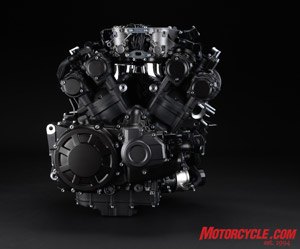 |
This time around, it’s been equipped with 52mm fork legs. The front fork is adjustable for preload, compression and rebound. Like me, after 24 years on the market, the rear shock is single. It’s fully adjustable, with remote adjustment.
The front brakes are dual 320mm wavy discs, grabbed by six-pot calipers. The master cylinder is a Brembo radial job. They would hardly be out of place on a superbike. It is badged a Star and might be ridden by a cruiser type, so it has a huge rear brake, too: a 298mm disc with a single-piston caliper.
We weren’t provided with weight, wheelbase, or rake/trail figures, but the overall impression (abetted by the sporty-looking BT028 Battlax ’Stones) is of a bike that should stop and turn a hell of a lot better than the original.
Yeah. So what, eh? It’s a #ü¢&ing V-Max. What about the motor?
Climbing up the Midway’s gangway, the only question I really had was, had Yamaha created a modern equivalent of the original V-Boost? Well, no. It’s been replaced by displacement.
The new mill is a 1697cc, 65-degree V-4 with a 90mm bore and 60mm stroke. You could probably drop one of the original 35mm carbs down the current 48mm throttle bodies. The old butterfly valve that siamesed the inlet tracts was a stroke of genius a quarter-century ago, but that stuff has no place in a modern, emissions-controlled world. The new bike has computer-controlled variable-length velocity stacks. Incidentally, those curved brushed aluminum dummy inlets on the original V-Max are functional on the new version.
There’s a single injector below the butterfly in each of those throttles. We weren’t told the valve diameters. The intake cams are chain driven, and the exhaust cams are geared from those. The compression ratio is 11.3 to 1.
All in all, it’s a pretty big air pump, squeezing the charge pretty hard. Yamaha hasn’t published horsepower or torque figures. (I’m reminded of Rolls Royce. Back in the day, they never published power figures for their cars. When asked, a spokesman once described it as “ample”.) Yamaha’s Bob Star went one better, though, telling the assembled journalists that the new V-Max produces 200.1 metric PS – about 197 American horses – with 120-plus ft-lbs of torque. That should be ample.
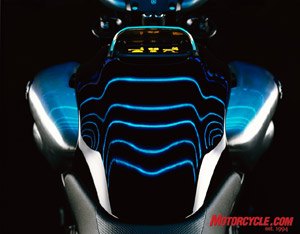 “Organic Electro Luminescence Multifunction Display” includes odometer, clock, dual trip and reserve trip, fuel gauge, gear-position indicator, coolant temp, mpg, intake air temp, throttle valve opening angle, stopwatch and countdown indicator. |
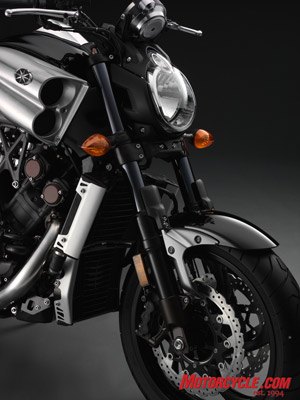 52mm fork is treated with titanium oxide and is adjustable for preload, compression and rebound. The top triple clamp is cast, bottom is forged. |
Exhaust gases are fed through a complicated 4-1-2-4 system of headers and collectors, into two massive titanium mufflers. They look as if they’ve been tucked away reasonably well.
That power is fed through a slipper clutch to a five-speed transmission. As with the original, the final drive is by shaft. Sure, it saps some power, but they know their market.
They should know it. As journalists milled around the bike on the Midway’s flight deck, I chatted with Mr. Ichijo and Mr. Umemoto (designer of the new version), as well as Norm Kerachuk who works at GDKI here in California. They told me that Yamaha had been noodling on a new V-Max since 1997, when they’d started the project in hopes of having it ready for the company’s 50th anniversary.
One thing that made the redesign a challenge was that every time they assembled a focus group of current V-Max owner/cult members, they were told not to change a thing. You can judge their success yourself from the photos here, but I will say that the bike looks better in the metal than in pixels, IMHO.
In terms of rider amenities, the bike presents little in the way of wind protection, but the neutral riding position should provide reasonable slow-speed comfort while giving owners the option of being an active participant on winding roads. The analog tach features a prominent shift light – the better to win the impromptu drag races that inspired the original creation. There’s also a cool, multi-function digital display with everything from a clock to a throttle butterfly-angle display. You might not want to look at that too closely while actually riding.
We’ll definitely ride this beast as soon as we can so we can tell you how much of what we loved about the original V-Max has been retained and how much of what scared us has been improved. But, frankly, if you think you want one, you probably can’t wait for even a “first ride” impression from us.
This year, Yamaha U.S. will be getting a limited allotment of 2,500 V-Maxes. They will be sold on a build-to-order basis, with a $1,000 deposit being the equivalent of slipping the doorman a twenty. Dealers will start taking orders today (June 4, as I write this). I strongly suspect that even by the time we’ve been given a chance to ride this bike, the first year’s edition will be sold out. Delivery is scheduled to begin in November. The MSRP is $17,990.
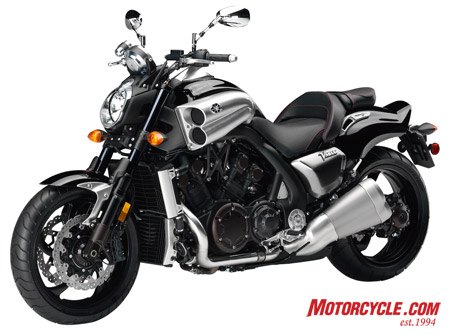
On the new V-Max the stylish air intakes actually take in air. The exhaust features an EXUP valve and its cans are titanium-wrapped.